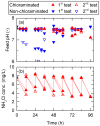Biofouling Mitigation by Chloramination during Forward Osmosis Filtration of Wastewater
- PMID: 30261685
- PMCID: PMC6210331
- DOI: 10.3390/ijerph15102124
Biofouling Mitigation by Chloramination during Forward Osmosis Filtration of Wastewater
Abstract
Pre-concentration is essential for energy and resource recovery from municipal wastewater. The potential of forward osmosis (FO) membranes to pre-concentrate wastewater for subsequent biogas production has been demonstrated, although biofouling has also emerged as a prominent challenge. This study, using a cellulose triacetate FO membrane, shows that chloramination of wastewater in the feed solution at 3⁻8 mg/L residual monochloramine significantly reduces membrane biofouling. During a 96-h pre-concentration, flux in the chloraminated FO system decreased by only 6% and this flux decline is mostly attributed to the increase in salinity (or osmotic pressure) of the feed due to pre-concentration. In contrast, flux in the non-chloraminated FO system dropped by 35% under the same experimental conditions. When the feed was chloraminated, the number of bacterial particles deposited on the membrane surface was significantly lower compared to a non-chloraminated wastewater feed. This study demonstrated, for the first time, the potential of chloramination to inhibit bacteria growth and consequently biofouling during pre-concentration of wastewater using a FO membrane.
Keywords: chloramine; forward osmosis; membrane fouling; pre-concentration; wastewater treatment.
Conflict of interest statement
The authors declare no conflict of interest.
Figures










Similar articles
-
Biofouling control of a forward osmosis membrane during single-pass pre-concentration of wastewater.Chemosphere. 2020 Oct;257:127263. doi: 10.1016/j.chemosphere.2020.127263. Epub 2020 May 30. Chemosphere. 2020. PMID: 32512337
-
Characteristics of organic fouling, reversibility by physical cleaning and concentrates in forward osmosis membrane processes for wastewater reclamation.Chemosphere. 2020 Apr;245:125787. doi: 10.1016/j.chemosphere.2019.125787. Epub 2020 Jan 2. Chemosphere. 2020. PMID: 31959357
-
Design considerations for wastewater treatment by reverse osmosis.Water Sci Technol. 2005;51(6-7):473-82. Water Sci Technol. 2005. PMID: 16004010
-
Forward osmosis for application in wastewater treatment: a review.Water Res. 2014 Jul 1;58:179-97. doi: 10.1016/j.watres.2014.03.045. Epub 2014 Apr 4. Water Res. 2014. PMID: 24762551 Review.
-
Characteristics and influencing factors of organic fouling in forward osmosis operation for wastewater applications: A comprehensive review.Environ Int. 2019 Aug;129:164-184. doi: 10.1016/j.envint.2019.05.033. Epub 2019 May 22. Environ Int. 2019. PMID: 31128437 Review.
References
-
- Ansari A.J., Hai F.I., Price W.E., Drewes J.E., Nghiem L.D. Forward osmosis as a platform for resource recovery from municipal wastewater—A critical assessment of the literature. J. Membr. Sci. 2017;529:195–206. doi: 10.1016/j.memsci.2017.01.054. - DOI
-
- Appels L., Lauwers J., Degrève J., Helsen L., Lievens B., Willems K., Van Impe J., Dewil R. Anaerobic digestion in global bio-energy production: Potential and research challenges. Renew. Sustain. Energy Rev. 2011;15:4295–4301. doi: 10.1016/j.rser.2011.07.121. - DOI
Publication types
MeSH terms
Substances
LinkOut - more resources
Full Text Sources
Other Literature Sources

